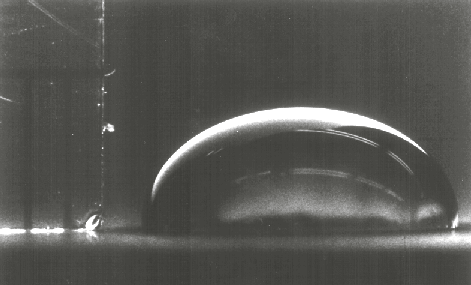Daniel M. Anderson
Freezing Water Droplets
Containerless solidification, in which the melt is confined by its own surface tension, is an important technique by which very pure materials can be produced. The form of the solidified product is sensitive to conditions at the tri-junction between the solid, the melt and the surrounding vapor. An understanding of the dynamics of tri-junctions is therefore crucial to the modelling and prediction of containerless solidification systems. We consider experimentally and analytically the simple system of a liquid droplet solidifying on a cold plate. Our experimental results provide a simple test of tri-junction conditions which can be used in theoretical analyses of more complicated systems. A new dynamical boundary condition at the tri-junction is introduced here and explains the surprising features of solidified water droplets on a cold surface.

This figure shows a water droplet at rest on an aluminum plate. The ruler shows millimeter markings. To see what happens when the plate is cooled so that the droplet freezes, click here.
Similar behavior can be observed in nature. For example, here is some frozen precipitation on a car.
Articles on this have been published by Anderson, Worster and Davis in J. Crystal Growth 163 (1996) 329-338 [ PDF version of this manuscript] and by Schultz, Worster and Anderson in "Solidifying sessile water droplets," in Interactive Dynamics of Convection and Solidification eds. P. Ehrhard, D.S. Riley and P.H. Steen (Kluwer, 2001). [ PDF version of this manuscript] Photographs and a write-up of this work may also be found in Science News 149 No. 22 (1996) 340-341.
To Daniel M. Anderson's Homepage